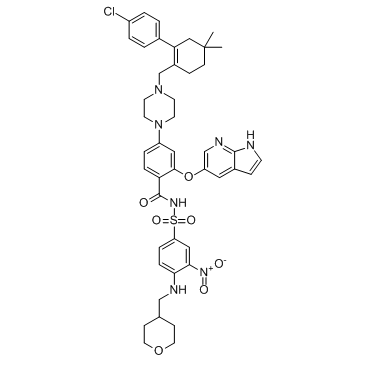1257044-40-8
| Name | 4-[4-[[2-(4-chlorophenyl)-4,4-dimethylcyclohexen-1-yl]methyl]piperazin-1-yl]-N-[3-nitro-4-(oxan-4-ylmethylamino)phenyl]sulfonyl-2-(1H-pyrrolo[2,3-b]pyridin-5-yloxy)benzamide |
|---|---|
| Synonyms |
GDC 0199
unii-n54aic43pw ABT 199 gdc0199 cs-1155 4-(4-{[2-(4-Chlorophenyl)-4,4-dimethyl-1-cyclohexen-1-yl]methyl}-1-piperazinyl)-N-({3-nitro-4-[(tetrahydro-2H-pyran-4-ylmethyl)amino]phenyl}sulfonyl)-2-(1H-pyrrolo[2,3-b]pyridin-5-yloxy)benzamide ABT199 ABT-199 Venetoclax Benzamide, 4-[4-[[2-(4-chlorophenyl)-4,4-dimethyl-1-cyclohexen-1-yl]methyl]-1-piperazinyl]-N-[[3-nitro-4-[[(tetrahydro-2H-pyran-4-yl)methyl]amino]phenyl]sulfonyl]-2-(1H-pyrrolo[2,3-b]pyridin-5-yloxy)- |
| Description | Venetoclax (GDC-0199; ABT-199) is a highly potent, selective and orally bioavailable Bcl-2 inhibitor with a Ki of less than 0.01 nM. |
|---|---|
| Related Catalog | |
| Target |
Bcl-2:0.01 nM (Ki) Bcl-xL:48 nM (Ki) Bcl-W:245 nM (Ki) |
| In Vitro | Venetoclax (ABT-199) potently kills FL5.12-BCL-2 cells (EC50=4 nM), Venetoclax (ABT-199) shows much weaker activity against FL5.12-BCL-XL cells (EC50=261 nM). ABT-199 also shows selectivity in cellular mammalian two-hybrid assays, where it disrupts BCL-2-BIM complexes (EC50=3 nM) but is much less effective against BCL-XL-BCL-XS (EC50=2.2 μM) or MCL-1-NOXA complexes[1]. |
| In Vivo | After a single oral dose of 12.5 mg per kg body weight in xenografts derived from RS4;11 cells (ALL), Venetoclax (ABT-199) causes a maximal tumor growth inhibition (TGImax) of 47% (P<0.001) and tumor growth delay (TGD) of 26% (P<0.05)[1]. Treatment of established xenografted (a mouse xenograft model of the T-ALL cell line LOUCY) tumors with Venetoclax (ABT-199) 100 mg/kg for 4 days resulted in a significant reduction of leukemic burden (P=0.0048)[2]. |
| Cell Assay | RS4;11 cells are seeded at 50,000 per well in 96-well plates and treated with compounds diluted in half-log steps starting at 1 μM and ending at 0.00005 μM. All other leukemia and lymphoma cell lines are seeded at 15,000-20,000 cells per well in the appropriate medium and incubated with Venetoclax or Navitoclax for 48 h. Effects on proliferation are determined using Cell TiterGlo reagent. EC50 values are determined by nonlinear regression analysis of the concentration-response data. Mouse FL5.12-BCL-2 and FL5.12-BCL-XL cells are propagated and assessed. Bak-/- Bax-/- double knockout mouse embryonic fibroblasts are seeded into 96-well microtiter plates at 5,000 cells per well in DMEM supplemented with 10% FBS. Venetoclax (ABT-199) in the same culture medium is added in half-log dilutions starting at 5 μM. The cells are then incubated at 37°C (5% CO2) for 48 h, and the effects on proliferation are determined using Cell TiterGlo reagent[1]. |
| Animal Admin | Mice[2] Nonobese diabetic/severe combined immunodeficient γ (NSG) mice are injected at 6 weeks of age in the tail vein with 150 µL phosphate-buffered saline containing 5×106 luciferase-labeled LOUCY cells. At regular time points, the bioluminescence is measured using the IVIS Lumina II imaging system. At 6 weeks, the cells are engrafted and the mice are randomly divided into 2 groups (with an equal number of males and females in both groups), and the treatment is started on day 0. Mice are treated with Venetoclax (ABT-199) 100 mg/kg body weight or with vehicle via oral gavage for 4 consecutive days. At days 0, 2, and 4 the bioluminescene is measured. Before imaging, the mice are injected intraperitoneally with 200 µL of a 15 mg/mL firefly D-luciferin potassium salt solution and anesthetized by inhalation of 5% isoflurane. The mice are imaged 10 minutes after luciferin injection. The total bioluminescence signal in each mouse is calculated via the region of interest tool (total counts) in the Living Image software. |
| References |
| Density | 1.3±0.1 g/cm3 |
|---|---|
| Molecular Formula | C45H50ClN7O7S |
| Molecular Weight | 868.439 |
| Exact Mass | 867.318115 |
| PSA | 186.58000 |
| LogP | 10.88 |
| Index of Refraction | 1.644 |
| Storage condition | -20°C |
| Water Solubility | Insuluble (6.3E-6 g/L) (25 ºC) |
